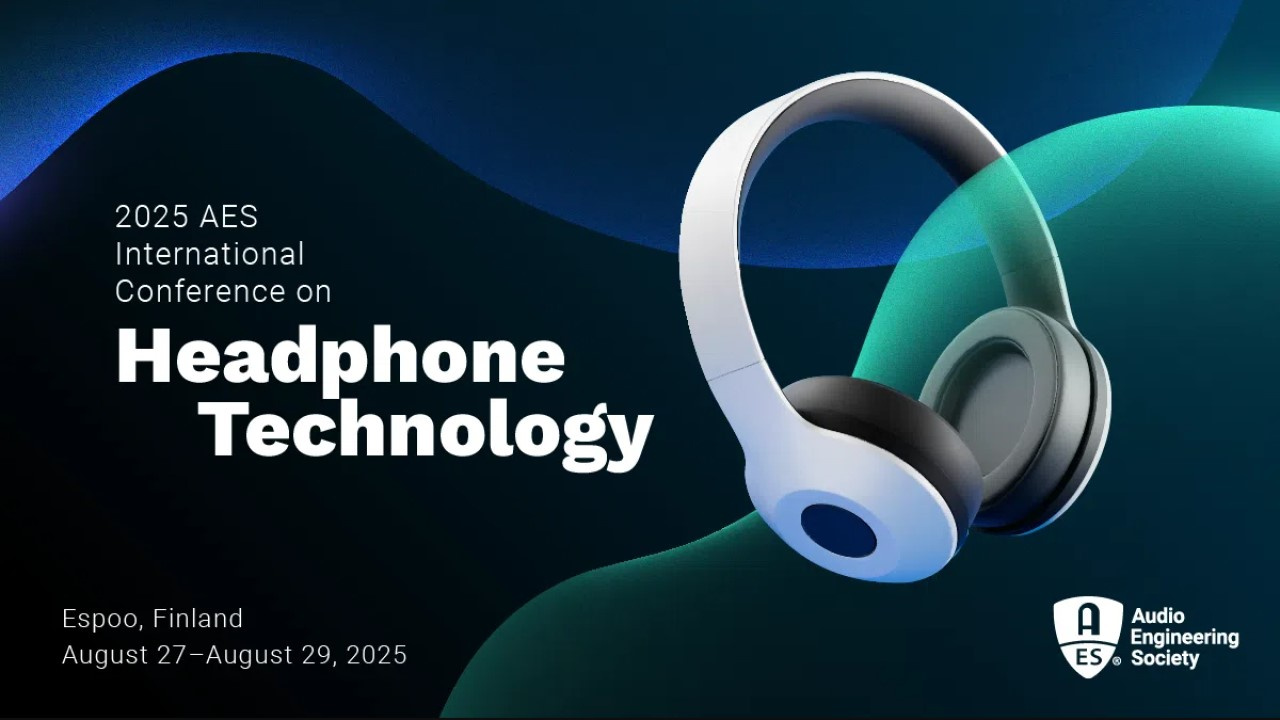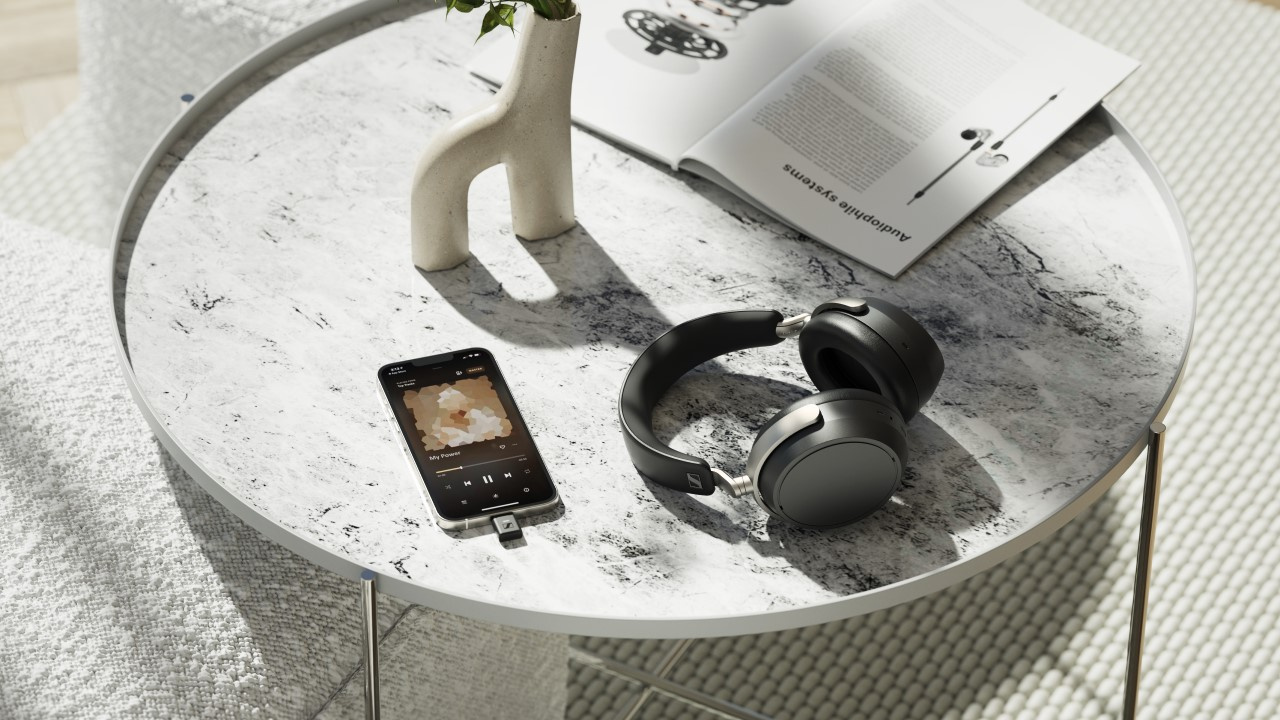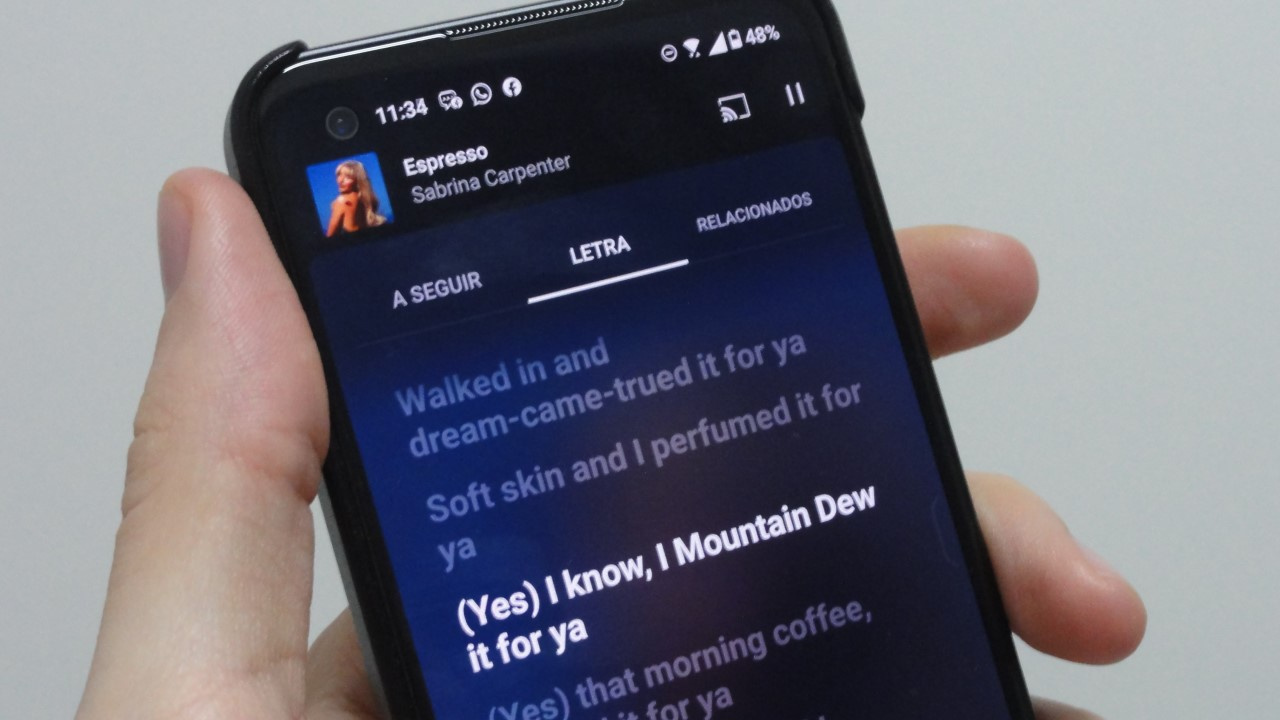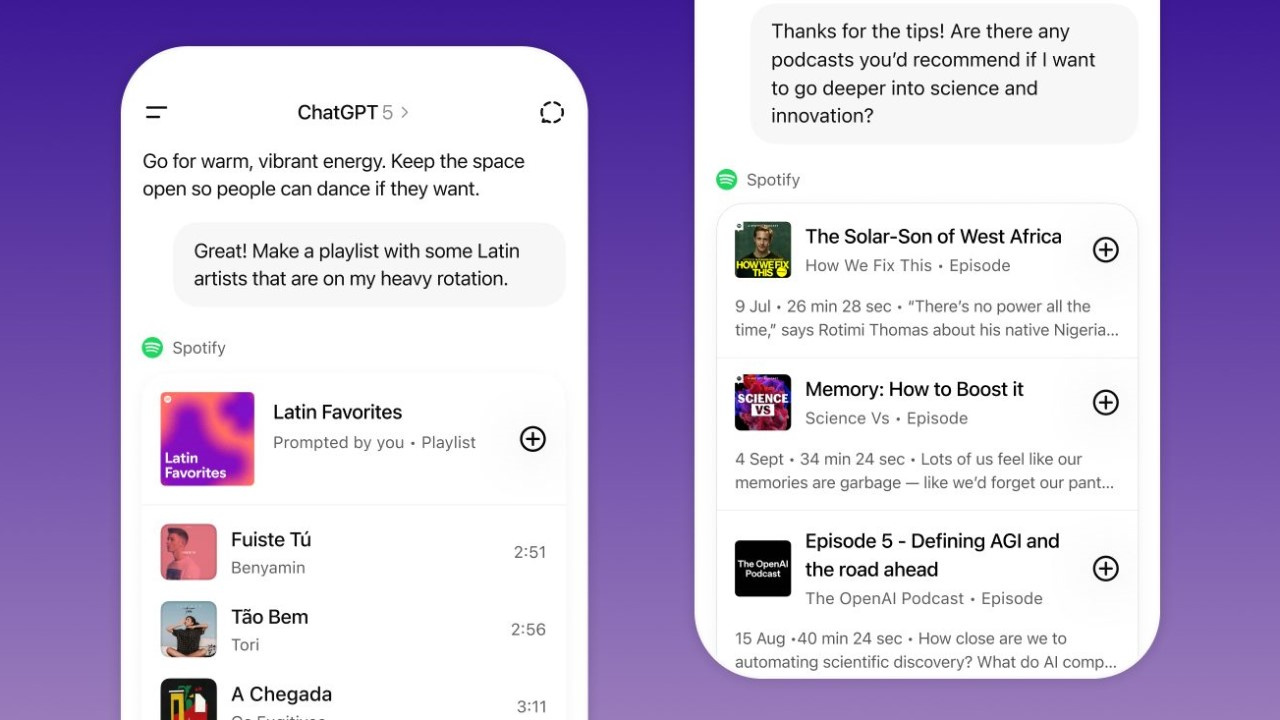Conferência internacional sobre tecnologias em fones é promovida pela AES
Por: Vitor Valeri
 Banner da International Conference on Headphone Technology promovida pela AES (Audio Engineering Society) (Imagem: reprodução/AES)
Banner da International Conference on Headphone Technology promovida pela AES (Audio Engineering Society) (Imagem: reprodução/AES)
Anualmente realizada pela AES (Audio Engineering Society), a International Conference on Headphone Technology (conferência internacional sobre tecnologias em fones de ouvido) ocorrerá nos dias 27, 28 e 29 de agosto. Nesta edição de 2025, o pesquisador de destaque (keynote) será Sean Olive, que não só se tornou um cientista famoso por ter desenvolvido a curva de referência/alvo Harman, mas também por suas diversas contribuições na AES, tendo figurado como presidente da associação.
De acordo com a Audio Engineering Society, suas conferências “são realizadas periodicamente em locais ao redor do mundo” e cada vez que são realizadas, há um “campo específico da engenharia de áudio” que é abordado. Através destes eventos, a associação tem como objetivo “criar um fórum entre profissionais dessa área”.
A ideia é que os palestrantes da conferência contribuam por meio da apresentação de seus artigos e troquem ideias no intuito de estimular o avançado da ciência e da tecnologia em nível internacional. Aqueles que não puderem participar, poderão acessar os arquivos das apresentações e registros das discussões do evento.
Geralmente, os materiais disponibilizados pós-evento são artigos, resumos e pôsteres apresentados durante a conferência. Desta maneira, é possível acessar diversos resultados de pesquisas e novos desenvolvimentos na área escolhida para ser abordada.
Segundo a AES, os anais dos congressos são disponibilizados “gratuitamente para todos os Membros da AES, para Assinantes Institucionais da Biblioteca Digital e a um custo simbólico para os demais”.
Palestras que irão ocorrer na International Conference on Headphone Technology
A International Conference on Headphone Technology (conferência internacional sobre tecnologias em fones de ouvido) iniciará na semana que vem, a partir de quarta-feira (27) e irá até sexta (29). Confira a seguir a lista de temas das palestras e seus respectivos palestrantes.
Quarta-feira (27 de agosto)
- The Preferred In-Ear Headphone Target Curve Based on Method of Adjustments (by Dr. Sean Olive – Harman International)
- An algorithm for customized audio equalization and transparency mode (by Ole Nielsen – Bose Corporation)
- Personalized Timbre Optimization Based on a New Auditory Personalized Timbre Optimization Based on a New Auditory Model for Stereophonic Sound Reproduction via Earphones (by Kimio Hamasaki – President ARTSRIDGE LLC; Nao Tojo – final Inc.; Atsushi Hara – final Inc.; Haruto Hirai – final Inc.; Shun Saito – final Inc.; Mitsuru Hosoo – final Inc.)
- Target Curve Selection by Differential Evolution (by Gabriele Ravizza- Perceptual Audio Evaluation Specialist, FORCE Technology; Julian Villegas – University of Aizu; Christer P. Volk – FORCE Technology; Tore Stegenborg-Andersen – Force Technology; Yan Pei – University of Aizu)
- Headphone Acoustics Basics (by Naotaka Tsunoda – Consultant)
- HeRMeS: An automated headphone repositioning and measurement system (by Roman Kiyan – Intitut für Kommunikationstechnik, Leibniz Universität Hannover; Stephan Preihs – Leibniz University Hannover, Institute of Communications Technology; Jürgen Peissig – Leibniz University Hannover, Institute of Communications Technology)
- Reduced Order Model of a Headphone Driver Including Detailed Loss and Damping Models for Transient Simulations (by Søren Winther Kristensen – Ole Wolff Acoustics; Mads Herring Jensen – COMSOL A/S)
- Estimating the sound pressure at the eardrum and ear canal transfer function with in-ear headphones (by Etienne Rivet – Harman International Industries; Calum Smeaton – Harman International Industries; Jeong-Woo Kim – Harman International Industries; Todd Welti – Distinguished Engineer, Harman International Industries; Dr. Sean Olive – Harman International; Jeff Baker – Harmon International Industries)
- A volume knob for ambient sound: seamless ambient sound adjustment in wireless headphones using hybrid active noise control (Philipp Merz – Bang and Olufsen)
- Balancing Sound Isolation and Situational Awareness: Evaluating Active Noise Control and Hear-Through Modes in Open vs. Closed-Ear Earbuds (by Zhen Ting Ong- Nanyang Technological University; Santi Peksi – Nanyang Technological University; Ee Leng Tan – Nanyang Technological University; Jun Wei Yeow – Nanyang Technological University; Woon-Seng Gan – Professor, Nanyang Technological University; Naotaka Tsunoda – Consultant)
- Enhancing Situational Awareness in Wearable Audio Devices Using a Lightweight SELD System (Zhen Ting Ong – Nanyang Technological University; Santi Peksi – Nanyang Technological University; Ee Leng Tan – Nanyang Technological University; Jun Wei Yeow- Nanyang Technological University; Woon-Seng Gan – Professor, Nanyang Technological University)
Quinta-feira (28 de Agosto)
- Objective and perceptual measurements of the effect of ear tip size on fit, comfort, and audio quality of earbuds (by Christopher Gribben – Bang & Olufsen; Sebastian Palmvig Gamst – Aalborg University; Jon Francombe – Bang & Olufsen)
- Subjective test method for evaluating ergonomics of in-ear and intra-concha headphones (by Markus Vaalgamaa – SoundlyFit; Laura Laaksonen – SoundlyFit)
- Sensitivity to noise cancellation, also known as “eardrum suck” (by Ole Nielsen – Bose Corporation; Janet Xu – Bose Corporation)
- Evaluating the Effectiveness of Virtual Listening Tests for Balanced Armature Headphone Drivers (by Jonas Hüsen – Institute of Sound and Vibration Engineering, Hochschule Düsseldorf; Markus von Berg – Institute of Sound and Vibration Engineering, Hochschule Düsseldorf; Jochen Steffens- Institute of Sound and Vibration Engineering, Hochschule Düsseldorf)
- Towards the practical feasibility of head-related sound field synthesis using multidriver headphones (by Benjamin Pries – Leibniz University Hannover, Institute of Communications Technology; Stephan Preihs – Leibniz University Hannover, Institute of Communications Technology; Jürgen Peissig – Leibniz University Hannover, Institute of Communications Technology)
- Comparison of Passive Transparent Headphones for Augmented Reality Audio (Alexander Mülleder – Kunstuniversität Graz; Nils Meyer-Kahlen – Aalto University)
- Head-Tracked Spatial Audio: What is the Motion-to-Sound Latency of your Device? (by Maximilian Kentgens – HEAD acoustics GmbH; Mihály Tamás Bárány – HEAD acoustics GmbH; Alexander Hallmann – HEAD acoustics GmbH; Christoph Nelke – HEAD acoustics GmbH)
- Two Fields, One Frequency: Where Audio Engineering Meets Audiology. A tutorial on integrating hearing health into headphone design (by Laura Sinnot – Sound Culture, Tuned)
- Perceptual Evaluation of Consumer Headphone Spatial Audio Systems (by Oliver Scheuregger – Engineering Manager, Advanced Technology, Bang & Olufsen; Sergio de Las Heras – Bang & Olufsen; Jon Francombe – Bang & Olufsen)
- Performance and limitations of bone conduction headphones: testing perceptual differentiation, spatial location and immersion for audio augmented reality experiences (by Simone Dalla Bella – International Laboratory for Brain, Music and Sound Research (BRAMS); Andrea Gozzi – Université de Sherbrooke; Dominic Thibault – Université de Montréal; Caroline Traube – Associate professor, Université de Montréal; Marco Liuni – Mezzo Forte)
- A Subjective Evaluation Methodology for Binaural Enhancement (by Jean-Marc Jot – Founder and Principal, Virtuel Works LLC; Garrett Treanor – New York University; Shaunak Ranade – New York University; Zhinuo Li – New York University; Daphna Harel – New York University; Agnieszka Roginska – Professor, New York University)
- One Listener, 16 HRTFs: Perceptual Insights into individualisation methods (by David Poirier-Quinot – Sorbonne Université, CNRS, Institut d’Alembert; Pablo Gutierrez-Parera – Telecom Research Institute TELMA, Universidad de Málaga, Spain; ITEAM, Universitat Politècnica de València, Spain; Brian F.G. Katz)
- History of Headphones (by Axel Grell)
Sexta-feira (29 de Agosto)
- Workshop on Earbud Ergonomics (by Laura Laaksonen – SoundlyFit; Markus Vaalgamaa – SoundlyFit; Tore Stegenborg-Andersen – Force Technology)
- RoomAcoustiC++: An open-source room acoustic model for real-time audio simulations (by Joshua Mannall – Institude of Sound Recording, University of Surrey; Lauri Savioja – Department of Computer Science, Aalto University; Annika Neidhardt – Institude of Sound Recording, University of Surrey; Russell Mason – Institude of Sound Recording, University of Surrey; Enzo De Sena)
- Evaluation of room simulation approximations for AR Audio considering a flipped loudspeaker scenario (by Joshua Mannall – Institude of Sound Recording, University of Surrey; Annika Neidhardt – Institude of Sound Recording, University of Surrey; Boyd Thwaite – University of Surrey; Enzo De Sena)
- A Study on the Influence of the Measurement Accuracy and Length of Long-Duration BRIRs on Binaural Sound Field Reproduction (by Yumi Fujii – Cear, Inc.; Yoshitaka Murayama – CEO/CTO, Cear, Inc.; Yasushi Honda – Cear, Inc.; Yuko Watanabe – Tokyo Denki University)
- Active Noise Cancellation Distortions in Headphones (by Steve Temme – Listen Inc.)
- Future of Headphones Towards AI Support and Immersive Listening (by Karlheinz Brandenburg – CEO, Brandenburg Labs)
- Sound Colour in Headphones Used for Monitoring (by Thomas Lund – Senior Scientist, Genelec OY; Tore Stegenborg-Andersen – Force Technology)
- Monitoring Standards and Headphone Listening (by Thomas Lund – Senior Scientist, Genelec OY; Tapio Lokki – Aalto University)
Onde e quando a International Conference on Headphone Technology irá acontecer?
A International Conference on Headphone Technology irá acontecer nos dias 27, 28 e 29 de agosto na Aalto University no Dipoli, edifício principal da universidade, que fica na rua Otakaari, 24. A instituição acadêmica fica no município de Espoo, na Finlândia, país localizado no norte da Europa. O cadastro dos participantes inicia às 8h EEST na quarta-feira.
Como participar da International Conference on Headphone Technology
Para participar da International Conference on Headphone Technology promovida pela AES (Audio Engineering Society), você deve acessar esta página e selecionar o botão “Register to Attend”.
Custo para participar do International Conference on Headphone Technology
Para membros da AES, o ingresso custa US$ 675. Já para estudantes membros da AES, o ingresso é vendido por US$ 405. Para não-membros da AES, o ingresso tem o valor de US$ 800.
Compartilhe:




Nenhum comentário foi feito, seja o primeiro!